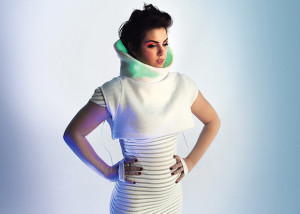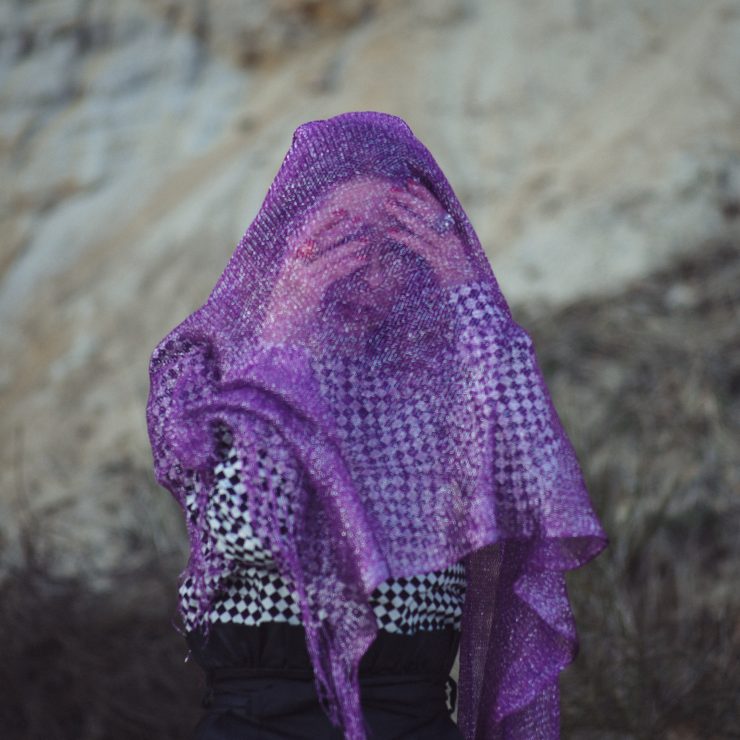We continue our series of featured articles on smart textiles: after healing textiles and camouflage ones, discover these projects around self-expression, emotions and social relations !
Textiles : emotion and creation
Iris van Herpen is a Dutch fashion designer for Haute Couture and ready-to-wear collections, based in Paris. She was the first one to assemble and sell robes that were 3D-printed, as we told you here. Iris van Herpen goes from experiments to tests, mostly on materials used: work on crystal, 3D printing of hybrid items between jewelry and clothes… Last September, she organized a happening in Paris, presenting clothes that interact with music instruments: a move, the way you stand would lead to different notes. Last year, another one of her projects focused on human body as conductive material for electricity: a dancer wearing a conductive robe was creating a storm by her only moves!
But Iris van Herpen is not the only one merging music and textiles: this is also the case of the Body Speaker project, created by Karina van Heck. This textile captures the sounds your body produces (heartbeat, flowing blood, breathes…) and merge them into a trance, repetitive music. The goal is to make you wonder about the concept of physical activity, but also the place of music in our lives.
Clothing, a platform for social relations and tenderness
Cute Circuit is the first brand of interactive fashion. Based in England, created in 2001 by an Italian and an American (Francesca Rosella & Ryan Genz), this start-up multiplies concepts using smart textile :some of their robes are woven with LEDs, allowing them to illuminate under certain circumstances, while some others can display tweets for example…

But their very first clothe is the one that intrigues us the most : the « hug shirt », a shirt embedded with sensors connected by Bluetooth, allows you to send a hug to the one wearing it, whatever country he is in. Technics seems simple: sensors are dispatched to contact points that heats up when someone hugs you; when you send a hug request by SMS, the receiver accepts it on his own smartphone, inducing a pressure and heat up in order to simulate a hug. This invention was at the moment available on the brand’s website: www.cutecircuit.com
Another close concept has been created by 3 MIT students, called Melissa Kit Chow, Andy Payne et Phil Seaton : it is called the Like-A-Hug Jacket. Here, no need to ask for a hug: the jacket is directly plugged in your facebook data, and inflates itself if you receive likes on your posts and comments. A really beautiful and smart way to introduce a bit more physical contact in this digital world, and to represent the attachment your family has for you.
Textiles to express your feelings
Cute Circuit also imagined a full range of clothes that are sewed with thousands of tini LEDs (up to 24,000 !) allowing you to change the color of your dress, display message, texts and pictures like an advertisement on Times Square… Of course, everything is achievable through your smartphone and items are washable in machine. Furthermore, if you create during a party a specific hashtag for your friends, you can also display their nice words on your clothes, through Bluetooth.

In the same field, Sensoree is a SF-based company we already presented you here, working on display concepts. They launched in 2011 a sweater called GER Mood Sweater. Using sensors for electrodermal activity, this sweater changes colors according to the state of mind of its wearer: red if he is stressed or angry, blue if he is calm, pink if he is aroused, as show this vidéo from the start-up.
Transparency, want it or not…
Other projects focus on social dimension, while looking for you to wonder: Xuedi Che & Pedro Oliveira, two designers from the New York University, created X.pose, a robe that becomes transparent if its wearer displays personal information on social networks.
Specifically, every time the woman wearing it connects to Facebook on her smartphone, the robe becomes less and less opaque. The more her publications are personal, the more transparent the robe will become. In fact, it is the amount of data shared on social networks, monitored by the electronic platform Arduino, that determinates how much transparent the robe should be. Then, the robe will activate or not the different screens composing the robe, some of them being specifically used for Twitter or Facebook. Thus, the two designers want to engage a discussion about social exposition, which is often underestimated, and the loss of anonymity on social networks.
Another transparent robe concept also surprised us: called Intimacy 2.0, this one changes according to your emotion. How exactly? The robe monitors you skin temperature, and can modulate its transparency thanks to the use of a conductive material. If your next boyfriend comes around you, your skin temperature will tend to rise up, and sensors will simulate transparency thanks to a little electricity. You then only have to play the sensuality approach, without showing too much…
The Look Forward Perspective
After textiles that heal or hide, new technological developments allow us to imagine textiles that show your emotions. This trend is a major one, and some of these projects were present at the WearableFestival launched by Look Forward in February 2016.
If most of these products are of course still prototypes, created to recall latest trends about technology (security, anonymity), or simply for the love of art, long term applications might be numerous: fight against depression and loneliness, boost for self-confidence…
All these very futuristic looks might be in our streets in a few decades, if a deep modification of production process is achieved!
